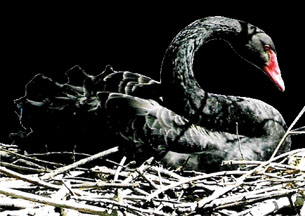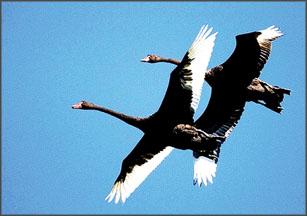|
Black beauties of the feathered kind
Have you read the popular children’s story the Ugly Duckling written
by the famous Danish poet and author Hans Christian Anderson? Well, if
you have, then you will remember how the ugly duckling in this story
(which was first published in November 1843), turned into a beautiful
swan one day. Were you fascinated with the beautiful white swan featured
in this story?
 |
|
The females nest during the wet
winter months. |
No doubt you were, because swans are definitely graceful and
beautiful creatures that attract the attention of many people the world
over. Today we decided to introduce you to a cousin of this ‘Ugly
Duckling’ who is not at all like the snow white swan portrayed in the
story, but a very graceful ‘black beauty’ in the avian world.
All of you must be very familiar with the white swans who are
regularly featured in many stories, poems, films and drawings. Black
swans are somewhat rare and in fact long before the discovery of the
existence of black swans, the metaphor ‘black swan’ was used to describe
something that could not exist or be true. It was an ancient western
concept that all swans were white.
This was proved wrong when an English naturalist named Dr. John
Latham described a large, black-feathered swan living in Australia, way
back in 1790. Since the 17th century discovery, black swans have been a
much studied animal species. So, let’s check out what the experts have
to say about these black beauties.
Often mistaken with the magpie-goose when in flight, during poor
light, the black swan (Cygnus atratus) is unlike any other bird in
Australia.
This large water bird is found in many parts of Australia, mostly in
the southeast and southwest regions, but not very common in central and
northern Australia. Its preferred habitats extend across fresh, brackish
and saltwater lakes, swamps, and rivers which are abundant with either
underwater or emergent (new and still developing) vegetation which the
birds use as food and nesting material.
As they generally prefer permanent wetlands, the black swans can be
found even in flooded pastures and tidal mud flats.
 |
|
When swimming the birds hold
their necks either arched or erect. |
 |
|
White flight feathers are
visible when flying. |
Even though this species of water bird is commonly referred to as
‘swans’, the male birds are known as cobs and females are called pens.
The young are called pens. The young one called cygnets. The cobs are
slightly larger than the pens. A mature black swan between 1.1 and 1.4
metres in length and weighs about 6.9 kgs.
The wingspan in flight is around 1.6-2 mts. This species of swans has
the longest necks among swans. The long neck takes the shape of the
letter S when the birds are eating or relaxing, but when in flight it is
generally held erect.
When swimming the birds hold their necks either arched or erect.
These birds could be seen flying by the numbers in a V formation at
speeds of 50 miles (80 kms) per hour. The birds generally fly at night
and rest during the day.
The swans are completely black feathered except for a line of white
flight feathers on the edge of wings which are visible when flying or
sometimes when they are at rest. The bill or beak is bright red with a
pale or white bar on the tip. The legs and feet (which are webbed) are
greyish black in colour. The eyes which are red are outlined by a thin
band of white on the lids.
Black swans live alone or in loose company, numbering around 100 or
1000 individuals. Closely related to the mute swan and the black-necked
swans, these birds were initially placed into a monotypic genus called
Chenopis. They communicate by whistling and making ultra musical and
far-reaching bugle-like sounds. When in flight too, these birds could be
whistling, trumpeting or bugling.
They were once thought to be sedentary (staying in one place) birds,
but now they are known to be nomadic (wandering) birds. However, they
have no set pattern of migration.
According to researchers, these large water birds travel from the
southwest and southeast of Australia into interior parts of the country
during rain fall and vice versa during the drought. They migrate mostly
to nest and raise young during rainfall. However, if dry weather returns
before the young or cygnets are raised, they’ll abandon the nests, eggs
and young to return to wetter areas.Like many other waterfowls, black
swans too settle on open waters for safety especially after breeding.
The females nest during the wet, winter months (February-September)
and this usually takes place in large colonies. The nests which are
turned out of reeds, grasses and weeds are about a metre in height and
between 1-1.5 mt in diameter. These large heaps or mounds of nests are
made in shallow water or on little islands and reused every year, after
some restoration or rebuilding is done. A typical clutch consists of 4-8
greenish-white eggs.
The eggs are incubated for about 35-40 days. After the eggs hatch,
the young are tended by both parents for six months until the
fledgelings are able to fend for themselves completely. The young
generally ride on the backs of parents when travelling far, in deep
waters even though they are able to swim and even feed themselves when
they are hatched.
 |
|
Mama with three cygnets. |
After breeding, the swans lose all their flight feathers during
moulting, so, they cannot fly for about a month.
They stay in open water to avoid predators during such times. And if
you are wondering what these birds eat to survive, it’s various types of
weeds, algae and vegetation.
The adult swans could be seen reaching under the water to eat water
plants. Cygnets feed on bugs and other small invertebrates since they
feed mostly on the surface of the water until they grow. These black
swans could also be seen occasionally, grazing on pastures.
Like all species of swans, the black swans too are monogannous; they
choose partners for life and as researchers say the ‘divorce’ rate in
this bird community stands at only six per cent, in contrast to that of
humans.
At present, naturalists claim that the current global population is
around 500,000 individuals and there is no threat of extinction to this
species. But going by the alarming rate other animal species are
diminishing or disappearing due to global warming, poaching, hunting and
loss of natural habitats, the fate of these birds too is in the balance.
Let’s hope that these graceful birds will not suffer the same fate
many of our other animal friends are facing today.
Fact File
* There are seven species of swans in the world. Except for the black
swans of Australia and the black necked swans of South America, all the
others are pure white.
* A Dutch sailor named Antonie Caen is believed to have seen a black
swan in the Shark Bay area in 1636.
* A Dutch explorer, Willem de Vlamingh captured several black swans
on the Swan River, Western Australia in 1697. (Many people didn’t
believe him).
* Black swans were scientifically described by Dr. John Latham in
1790 and accepted to be true only after that.
* The black swan is very aggressive when defending its nest and eggs
from intruders.
* Cygnets are led to the water by the parents after 24 hrs of
hatching.
* The black swan is the state bird of Western Australia.
* Swans as well as ducks and geese are members of the Antidae family
in the order Anseriforues.
* The black swan is New Zealand’s largest wetland bird.
* Black swans breed either in pairs or in colonies.
* About 5,000 birds are shot annually in New Zealand.
* The black swan is the most social and least territorial of all
swans.
* The cygnets stay with the family unit for about nine months even
though they have the ability to fly away by the time they are two months
old.
* The cygnets are greyish in colour and fluffy too.
* The black swan has 22-25 vertebrae in its elongated neck. It is
because of this that the bird can duck its head under the water to eat
aquatic vegetation deep down.
* The beaks have grooves that help in the feeding process.
* They are good swimmers, but do not dive.
* Black swans were introduced to New Zealand as a game bird and an
ornamental water fowl way back in 1864.
They also became popular as ornamental water birds in western Europe,
especially in Britain.
Facts and pix: Internet.
|
